So you’ve decided to build your own computer. Kudos to you for taking on the ultimate task in component customization — we promise it’s an incredibly rewarding experience. However, when things go wrong and your PC won’t turn on, it can feel demotivating and sometimes overwhelming to solve.
We’ve put together a list of the most common reasons your home-built PC won’t start and exactly how to solve them quickly and easily.
PC won’t turn on

This might be the most demoralizing of all PC fixing problems, because you don’t have much to go on when your PC won’t turn on. However, the fact that nothing happens is a clue in and of itself. Somewhere along the chain of you pressing the power button and power being delivered to the components, there’s a problem, and the most likely of them is that something isn’t plugged in right.
So, first things first. Is the power cable plugged into the wall and the other end into your power supply? Are the wall socket and PSU switched on? Double-check each end to make sure everything is connected properly. It’s also worth checking that your motherboard and CPU power cables are plugged in correctly. For more information on that, check out our comprehensive PC build guide.
If you’re still getting absolutely nothing when you press the power button, look to see if your motherboard has any idle indicator lights to confirm that the motherboard is definitely receiving power. If not, then you might need a new power supply. We’d suggest swapping out the power cable you’re using, and possibly trying a different wall socket before going down that road, though. If you do need to buy a new power supply, we’d recommend these.
If you are getting power to your motherboard, the next thing to check is that your front-panel button is connected properly. It’s different for every case, but most have a thin series of cables that run from your front panel (that includes the power button, indicator LEDs, and any front-panel I/O ports) and connects to a point usually found on the bottom-right of your motherboard.
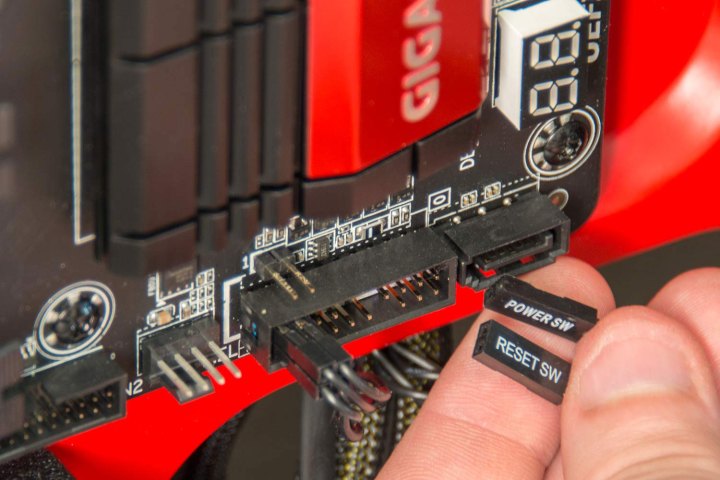
Remove your case’s side panel and locate that cable. Make sure it runs to the motherboard and is well connected. The pin location and layout will vary by case and motherboard, but it should look like a two-wide row of pins, usually encased in a plastic outer box.
The ends of the cables will say, for example, “HDD LED” or “PWR,” and some of them have positive and negative contacts. Make sure these are completely seated on their corresponding pin, which is either marked next to the pins on the motherboard, or in your motherboard’s documentation.
If in doubt, pull them out and plug them back in again.
There’s noise or lights, but nothing appears on screen
If your system starts but doesn’t boot, search below for the relevant section. But if when you hit the power button, fans spin up and lights turn on while nothing appears on the screen, it’s quite likely to be a hardware issue of some kind.
Before we start digging into the system to try to figure out what’s wrong, make sure that you are protected as best you can be from static buildup. That includes working on a flat, non-conductive surface like a wooden or plastic desk. Wearing shoes, if you’re on carpet, isn’t a bad idea either.
Ideally, you’ll have an anti-static wristband in hand, but if not, make sure your system’s PSU is turned off (it should be when you’re working on it anyway) and periodically touch the case to ground yourself.
Check the monitor
It might seem an obvious step, but you’d be surprised how often it’s passed over. Check that your monitor is plugged in and has the right connection to your PC. Check the indicator lights to see if the monitor is really turning on. Make sure the monitor cable you are using is working properly. Sometimes, although less frequently, brightness levels turned all the way down can make a monitor look off when it’s not, so tweak the brightness and other settings.
Diagnostic codes and beeps
Many modern motherboards will give you an idea of what’s wrong if you know where to look and/or listen. If turning your system off gives you a series of particular beeps, or your motherboard has a display on it that shows a particular error code, use your motherboard’s manual to diagnose the problem.
Some of them can be as mundane as you forgot to plug in a power cable, while others will tell you that your CPU is damaged and needs replacing. Each manufacturer uses different indicators to tell you what the problem is, so you’ll need to refer to your documentation to translate the error code on your machine.
Whether your system gives you a useful error code or not, though, there are still a few different fixes you can try to sort the problem out.

Is something shorting?
If your system powers up, the fans spin, the lights turn on, and then everything turns off after half a second, only for it to repeat in a never-ending loop, there may be something metallic shorting out the system somewhere.
A short occurs when a component in a system creates an improper electrical connection between components. For example, a frayed wire might be brushing the motherboard, or a portion of the case may be touching a component. Did you drop a screw behind the motherboard? Make sure all wires are intact, that no portion of the case is directly contacting exposed PCB, and that the motherboard is installed in the case on standoffs that elevate it from the case surface.
This is a difficult problem to diagnose, especially from our perspective, but if your system has these symptoms you should probably keep a short in mind.
The best way to make sure this isn’t the case is to take everything out and rebuild it outside of the case, but that’s an extreme measure. If you think there might be an errant screw somewhere causing problems, tilting the case from side to side can help you find out where it is.
Reset the CMOS
It’s possible that instead of a hardware problem, you’re facing a weird compatibility problem or settings error in your system’s BIOS. That’s the code that runs before your operating system starts up and helps configure the PC for use. If this is causing the problem, it’s a relatively easy fix.
If your motherboard has a CMOS reset switch or button, use that — refer to your motherboard manual for instructions on how best to use it.
Otherwise, you’ll want to remove the power cable from your PC, then locate the flat, silver battery on the motherboard itself. Remove it, press and hold the power button on your PC for 30 seconds, and then plug the battery and the power cable back in and try again.
If your motherboard is older than your CPU, they may also have some small compatibility issues that are preventing your computer from starting. You should work on updating the BIOS entirely if it looks like this could be an issue.
Note: If you had any custom BIOS settings like fan profiles, overclocking, or specific drive configurations, you will need to redo those settings.
Power
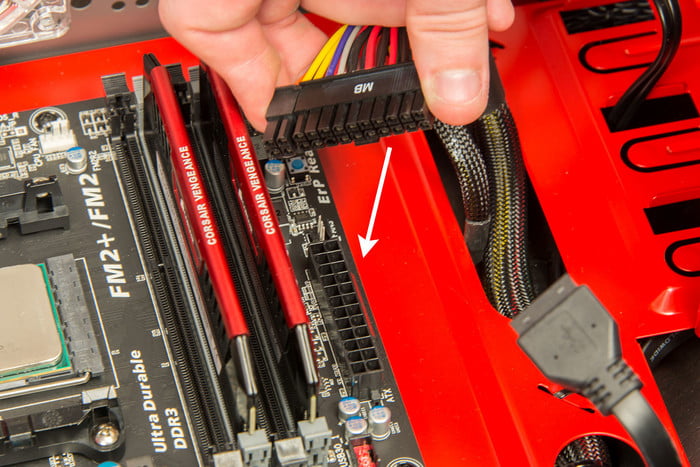
There are a lot of different power plugs in a system, and it’s all too easy to miss one of them when your PC won’t turn on. One of the most common is the 4/8-pin connector next to the CPU. There’s already a wide 24-pin connection, which you should also check, but a lot of builders overlook the smaller CPU power connection.
Then, just run through the other parts in the PC and make sure there’s power running from the power supply to each one. In a typical build, that means hard drives and optical drives, but it could also include a PCIe expansion or graphics card. If you have a modular power supply, also ensure all of the cables are plugged into the correct spot on the PSU and are running to the right component.
If everything is plugged in correctly, consider unplugging everything but the essentials and trying to start the PC again. If it works, you can gradually plug everything back in and discover what may be at fault. The components that you will need at a minimum are:
- Motherboard 24-pin and 4/8-pin power cables.
- CPU cooler.
- Graphics card (unless you’re using the CPU’s onboard GPU) and any required 6/8-pin power cables.
- A single stick of memory.
- Your boot drive and its power connector and data cable.
CPU
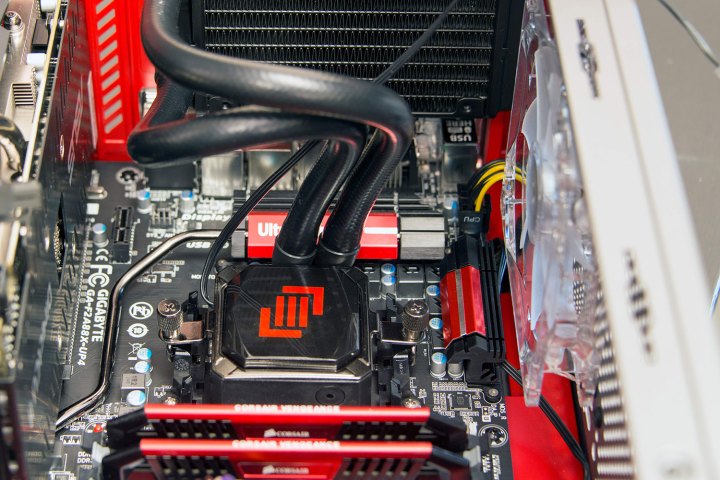
Installing a CPU is relatively simple, but it’s always possible something’s gone awry, such as the cooler not sitting flush with the processor, or you’ve forgotten to lower the retention arm.
If you think it’s your CPU that’s the problem when your PC won’t turn on, consider removing it and reinstalling it from scratch.
Intel CPUs only fit in one direction because of a pair of notches at one side of the chip that fit against notches in the socket. If you installed the chip yourself, there’s a piece of black plastic that sits in the motherboard slot to protect the pins — make sure it was removed before installing the cooling. A frame around the outside of the socket holds the chip in place, and a small arm right next to it should be clamped down and tucked underneath the clip at the end. It takes a fair bit of pressure to clamp the chip down.
With AMD CPUs, look for a golden triangle on one corner of the chip, and line it up with the triangle on the socket. Once it’s seated fully into the socket, carefully lower the arm next to the socket to clamp the chip in place.
An improperly installed processor can also mean bent pins, a damaged cooler, and possibly a compromised motherboard. Check the surrounding area for damage, like bent pins in the socket or CPU, before reinstalling the chip.
If you do see bent pins, that’s the likely culprit for your problem. This damage can result in not only CPU error codes, but also memory error codes, as a bent pin can impact how the CPU read and writes from RAM.
We’d caution against trying to fix this kind of problem yourself unless you really know what you’re doing. At this point, lots of additional research is required, or ideally, contact a professional to help you.
Memory
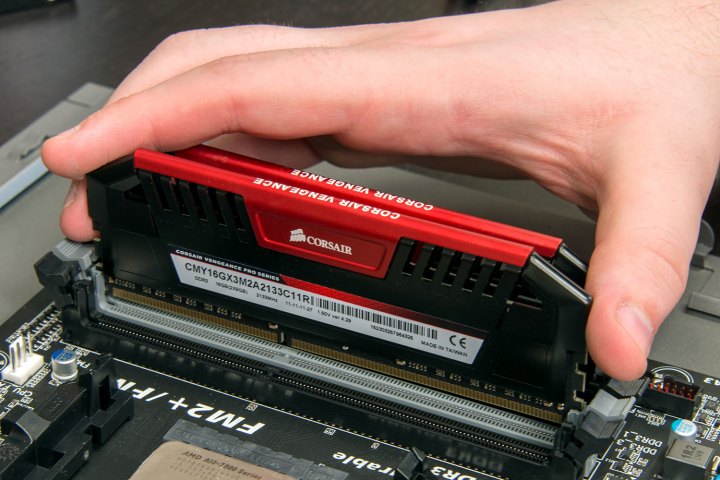
Memory problems can be the cause of all sorts of PC issues. If you think yours might be causing yours, here’s how to check.
Before pulling anything out, make sure that the memory you installed is the right type for your system. Did you buy the right generation — DDR4, DDR5, etc.?
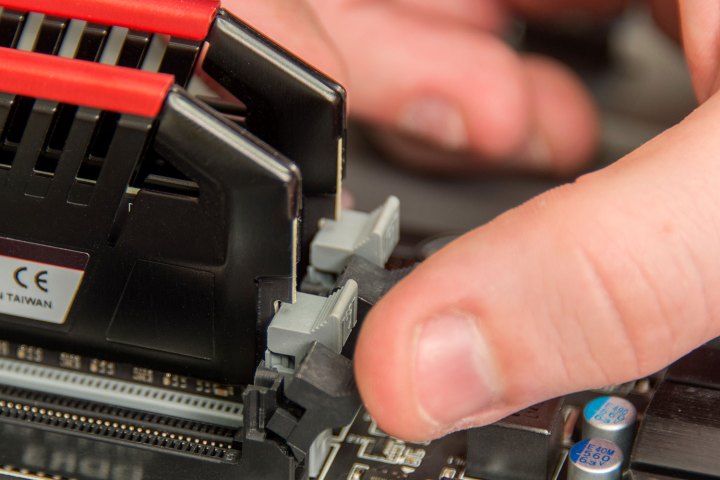
Assuming you have the correct memory, it has to be installed in the proper slot or slots, facing the right direction and fully seated. Check your motherboard documentation for the proper slot configuration. If you bought a dual-channel kit, with two identical sticks of memory, they usually have an empty slot between them, but it varies between Intel and AMD. After determining the proper slots, line up the notch on the bottom edge of the stick with the plastic riser in the slot. Push down firmly until the tabs on either side of the slot click inwards and grab the notches at each end of the RAM. If the notch is ajar, the RAM is not fully installed. Even if it looks like the RAM is properly seated, it’s a good idea to take it out and reseat it to make sure there are no problems.
It can also be worth trying to boot with just a single stick of RAM in to see if the other one might be defective. You can also change the slot you plugged the module(s) into — to see if any slots may be damaged and causing your booting issues.
Graphics card
The easiest way to diagnose a graphics card problem is to try to use another one. If you have a spare lying around, remove the original and plug that in instead and see if the system boots. If it does, your other GPU may be the problem.
If you don’t have a spare graphics card, but your PC has onboard graphics, then you can still test your graphics card. Uninstall your graphics card and then plug your display into the motherboard’s display output. If the system boots, then it could be that your graphics card was the problem.
If you do think your GPU is the problem, try plugging it back in anyway. Sometimes reseating a component can be all it takes to fix it.
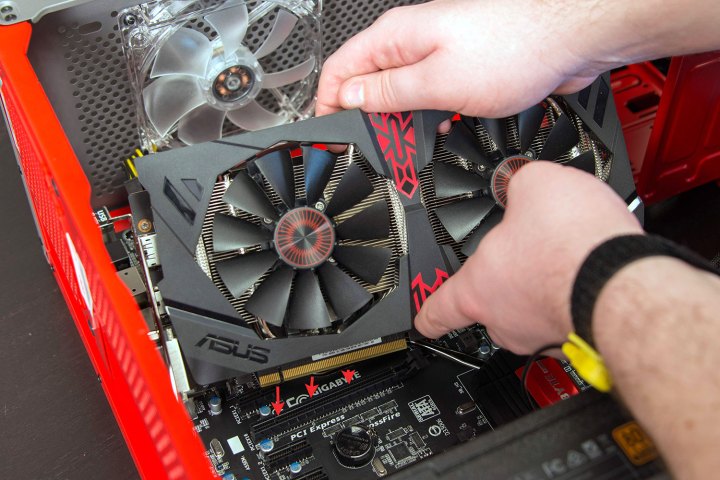
Bill Roberson/Digital Trends
Also consider trying different PSU cables for its power if possible. It’s also a good idea to try it in a different PCIExpress slot on your motherboard if you have one. If you have a separate GPU, double-check that your monitor is plugged directly into the graphics card, not the video port on your motherboard. If the monitor seems to be the component that’s not working, try connecting a different display to see if that helps. You may also be interested in our guide on multi-monitor troubleshooting for more complex setups, but generally, it’s a good idea to start with just one screen and add more monitors once everything is running properly.
Cooler
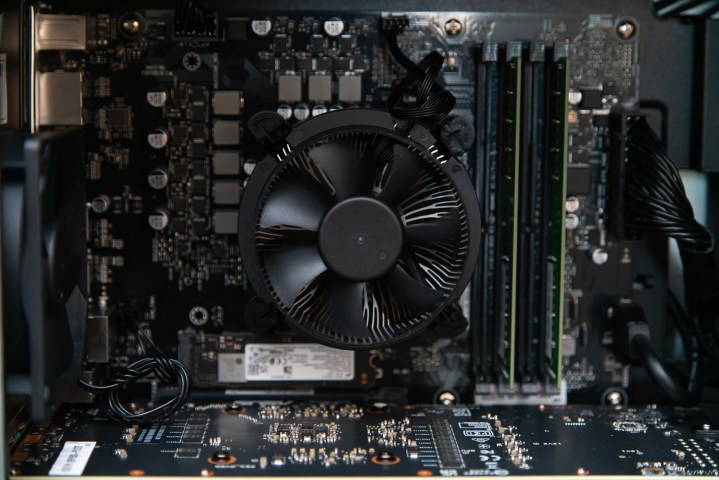
Does your PC turn on for a short period and then crash unexpectedly? Does your processor significantly heat up during this trial run? This could be a sign that your cooler isn’t working as it should. Sometimes coolers can be defective, but it’s also possible that your cooler has an installation problem. First, check to see if you can hear it: If it doesn’t sound or seem like the cooler is running at all, make sure the fan is properly plugged into the motherboard’s fan header. The fan header should be labeled on most motherboards, making this an easy check, although more complicated coolers may require a couple of different connections depending on the design.
If the fan is running properly and fully connected, it could be a problem with using the thermal paste to connect the cooler to the CPU. The thermal paste is vital to enabling heat to flow from the processor to the cooler: Too light a touch when seating the cooler, or the wrong kind of paste for the job, and your cooler won’t be able to siphon off heat properly. If you suspect that’s the problem, the best option is to reseat your cooler, and the sooner you do this, the better, as you don’t want your processor to overheat again.
Detach the cooler, remove any bits of dried thermal paste that may be in the way (99% isopropyl alcohol is really useful for this), and reseat the cooler with a new dot of thermal paste in the center. Then seat the cooler carefully on top of the processor, and tighten any brackets or screws partially, sequentially, so that you don’t overload any one side of the cooler’s mounting and put undue pressure on any particular part of the processor. Remember, you don’t need much thermal paste, and the paste should never squeeze or run out the sides when you are seating.
Collateral damage
When all else fails, check every component on the board for physical damage. It may not be immediately obvious that something is wrong, so check thoroughly for anything that looks out of the ordinary, or even bent or damaged heatsinks and PCBs.
The other danger you face when building a computer is static electricity. Unfortunately, parts that have been damaged due to exposure won’t necessarily show any physical signs. If for whatever reason you suspect static buildup is responsible for a component failing, you’ll have to replace it with one that works to confirm that’s the issue.
The system begins to boot, but fails
If the system is successfully turning on, and a signal appears on the screen, but it doesn’t reach the actual operating system before shutting down, the list of possible problems is a lot shorter.
First, we’ll check the hard drive’s physical connections. Whether it’s an SSD or mechanical drive, it requires two connections, one for power, and one for data. The power cable should run from the power supply to the drive, but there may be other similar connections on the same cable for multiple drives.
SATA is the most popular data connection if you own a relatively modern computer system. SATA is a small, thin plug with an L-shaped bend in the tip, which will run from the drive to a row of plugs on the motherboard.
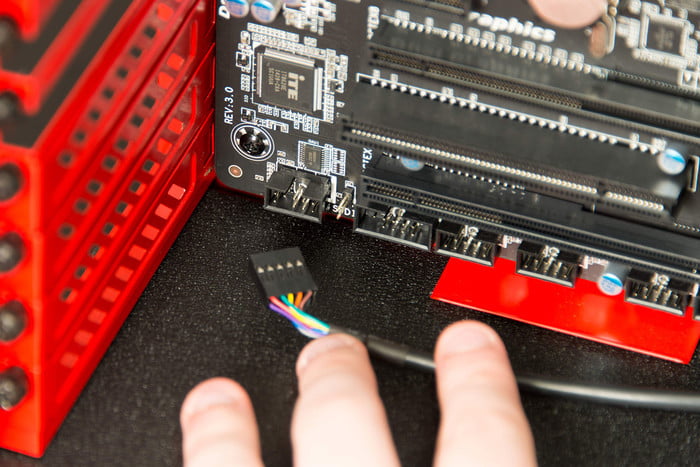
The motherboard manual will specify which plug is which, with different speeds and capabilities amongst the options. Check the motherboard for markings to identify the plug quicker if you need to save time. If your motherboard has any additional settings options, like RAM optimization modes for gaming, make sure they’re shut off for now — you’ll want to avoid any overclocking that could be shutting down your PC before it can get properly started. Once you have everything up and running well, you can start working on overclocking strategies if you prefer.
Often, resetting the CMOS is all you need to fix your PC’s posting and booting problems. Use the motherboard’s reset button. If it doesn’t have one, you’ll have to remove the battery.
If the OS logo stays on screen while the PC is rebooting, there may be an installment issue. You can try booting to safe mode on a Windows program. If you recently switched to Windows 11, the new operating system may be putting more pressure on your hardware, which can cause boot failures on older equipment. Make sure your PC can run Windows 11, or be prepared to switch back to Windows 10 if necessary.
If all else fails, try resetting Windows and check out our helpful guide on how to restore Windows to its original settings.
There’s no sound
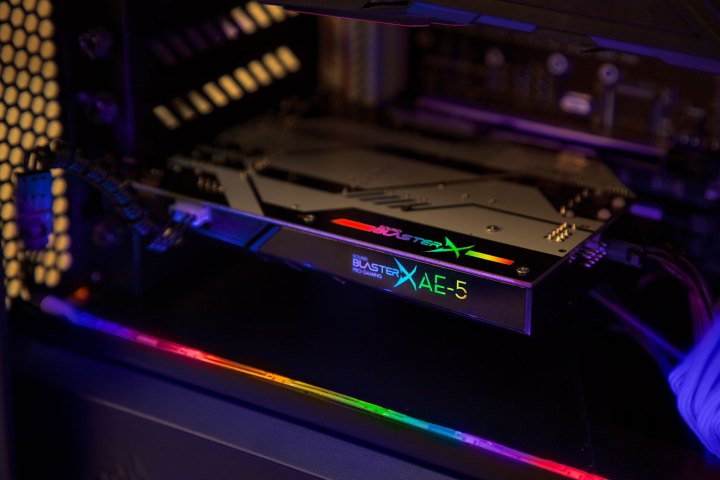
Always start by checking manual volume settings and making sure your sound is not turned low or muted — this can happen by accident when you’re working on your PC.
If you are using external speakers, unplug them and see if your monitor’s built-in speakers are functioning (if they have them). If they are, turn your PC off, plug the external speakers back in, then turn the computer on again. You should also visit your Sound Control Panel in Windows 10/11, go to Playback, and make sure the right speakers are set as Default.
It’s also possible that something has happened to your speaker drivers. You can check on this by searching for Device Manager, and locating your speakers or sound card. Right-click on them, and choose to search for and update drivers.
You may also want to try updating the BIOS if you are running an older system and nothing else is working.
Bluetooth isn’t working

If devices aren’t connecting via Bluetooth, start by making sure that it is turned on. You can find Bluetooth manually by going to Settings, then Devices, then Bluetooth & Other Devices. If Bluetooth is off, turn it on. If it’s on, turn it off for a few seconds, then turn it back on. If your PC has already paired with a Bluetooth device, remove that device now and try adding it again to see if it will work.
It’s also a good idea to check that your Bluetooth device is fully charged and turned on, especially if you don’t see it as a pairing option. If you’re on a laptop, check that the Airplane Mode isn’t enabled.
If your Bluetooth doesn’t appear to be functioning at all, you can go to Settings > System > Troubleshoot, and find the Bluetooth troubleshooter. Run it, and it should fix problems like drivers that haven’t been updated, etc.
If nothing is working, you can head back to Device Manager, find your Bluetooth, and right-click to choose Uninstall Device. Reboot your PC afterward, and it should automatically re-install Bluetooth so you can check it again.
The PC takes too long to boot
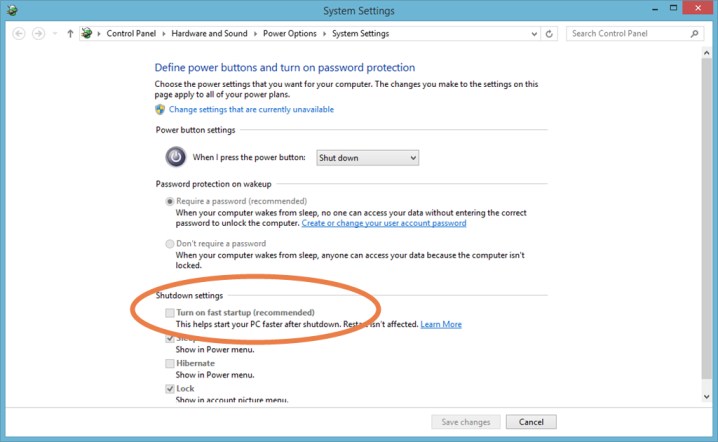
Sometimes your PC may successfully boot, but it will take much too long. If this happens repeatedly, there are several things you can try to fix the issue.
First, make sure Fast Startup is disabled. This feature is usually enabled automatically, but can sometimes cause problems when the PC is booting. You can find it by going to Settings, System, then Power & Sleep. Here choose Additional Power Settings, and in the new window, select Choose What the Power Buttons Do. Now select Change Settings That Are Currently Unavailable (you’ll need administrator credentials for this). Disable Turn on Fast Startup, and select Save Changes to finish.
Sometimes issues with your GPU can also cause lengthy boot times. You can visit Device Manager and head to Display Adapters to find your graphics card, then choose to Update Driver to see if this improves things.
If you’ve been playing around with Linux in Windows, you will want to try turning off your Linux shell to see if this solves booting problems. Search for Windows Features, and make sure the Windows Subsystem for Linux is turned off.
Connected peripherals aren’t functioning or detected
Start by checking that peripherals are properly connected and functional. If you can, hook them up to a different computer and see if they work there.
If the hardware all appears to be working correctly, it’s time to head to the drivers again. Go to Device Manager, and find the peripherals that aren’t working. Right-click and choose the Uninstall option to remove their drivers. Reboot your PC and wait for it to install the drivers again. This can often fix issues with peripherals not being detected or working.
Editors’ Recommendations




